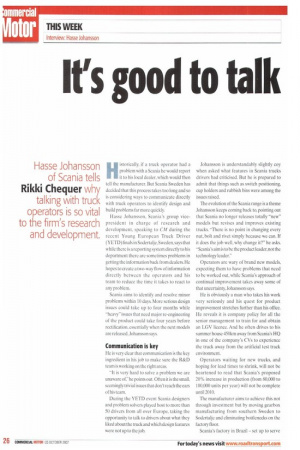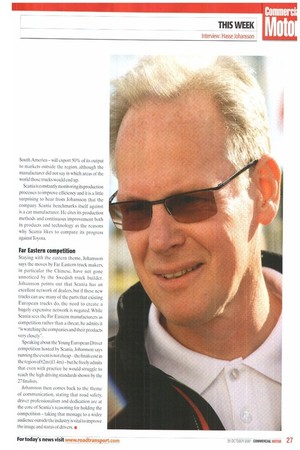t's good to talk
Page 26

Page 27

If you've noticed an error in this article please click here to report it so we can fix it.
Hasse Johansson of Scania tells Rikki Chequer wh talking with truc operators is so vital to tie firm's research and development.
Historically, if a truck operator had a problem with a Scania he would report it to his local dealer, which would then tell the manufacturer. But Scania Sweden has decided that this process takes too long and so is considering ways to communicate directly with truck operators to identify design and build problems far more quickly.
Hasse Johansson, Scania's group vicepresident in charge of research and development, speaking to CM during the recent Young European Truck Driver (YETD) finals in Sodertalje, Sweden, says that while there is a reporting system directly to his department there are sometimes problems in getting the information back from dealers. He hopes to create a two-way flow of information directly between the operators and his team to reduce the time it takes to react to any problem.
Scania aims to identify and resolve minor problems within 10 days. More serious design issues could take up to four months while "heavy" issues that need major re-engineering of the product could take four years before rectification, essentially when the next models are released. Johansson says.
Communication is key He is very clear that communication is the key ingredient in his job to make sure the R&D team is working on the right areas.
"It is very hard to solve a problem we are unaware of," he points out. Often it is the small, seemingly trivial issues that don't reach the ears of his team.
During the YETD event Scania designers and problem solvers played host to more than 50 drivers from all over Europe, taking the opportunity to talk to drivers about what they liked about the truck and which design features were not up to the job. Johansson is understandably slightly coy when asked what features in Scania trucks drivers had criticised. But he is prepared to admit that things such as switch positioning, cup holders and rubbish bins were among the issues raised.
The evolution of the Scania range is a theme Johansson keeps coming back to, pointing out that Scania no longer releases totally "new" models but revises and improves existing trucks. "There is no point in changing every nut, bolt and rivet simply because we can. If it does the job well, why change it?" he asks. "Scania's aim is to be the product leader, not the technology leader."
Operators are wary of brand new models, expecting them to have problems that need to be worked out, while Scania's approach of continual improvement takes away some of that uncertainty, Johansson says.
He is obviously a man who takes his work very seriously and his quest for product improvement stretches further than his office. He reveals it is company policy for all the senior management to train for and obtain an LGV licence. And he often drives to his summer house 450km away from Scania's HQ in one of the company's CVs to experience the truck away from the artificial test track environment.
Operators waiting for new trucks, and hoping for lead times to shrink, will not be heartened to read that Scania's proposed 20% increase in production (from 80,000 to 100,000 units per year) will not be complete until 2010.
The manufacturer aims to achieve this not through investment but by moving gearbox manufacturing from southern Sweden to Sodertalje and eliminating bottlenecks on the factory floor.
Scania's factory in Brazil — set up to serve South America — will export 50% of its output to markets outside the region, although the manufacturer did not say in which areas of the world those trucks would end up.
Scania is constantly monitoring its production processes to improve efficiency and it is a little surprising to hear from Johansson that the company Scania benchmarks itself against is a car manufacturer. He cites its production methods and continuous improvement both in products and technology as the reasons why Scania likes to compare its progress against Toyota.
Far Eastern competition Staying with the eastern theme, Johansson says the moves by Far Eastern truck makers, in particular the Chinese. have not gone unnoticed by the Swedish truck builder. Johansson points out that Scania has an excellent network of dealers, but if these new trucks can use many of the parts that existing European trucks do, the need to create a hugely expensive network is negated. While Scania sees the Far Eastern manufacturers as competition rather than a threat, he admits it "is watching the companies and their products very closely-.
Speaking about the Young European Driver competition hosted by Scania, Johansson says running the event isnot cheap—the finals cost in the region of E2m (i I Am )— but he freely admits that even with practice he would struggle to reach the high driving standards shown by the 27 finalists.
Johansson then comes back to the theme of communication, stating that road safety. driver professionalism and dedication are at the core of Scania's reasoning for holding the competition — taking that message to a wider audience outside the industry is vital to improve the image and status of drivers.


























































































































































































